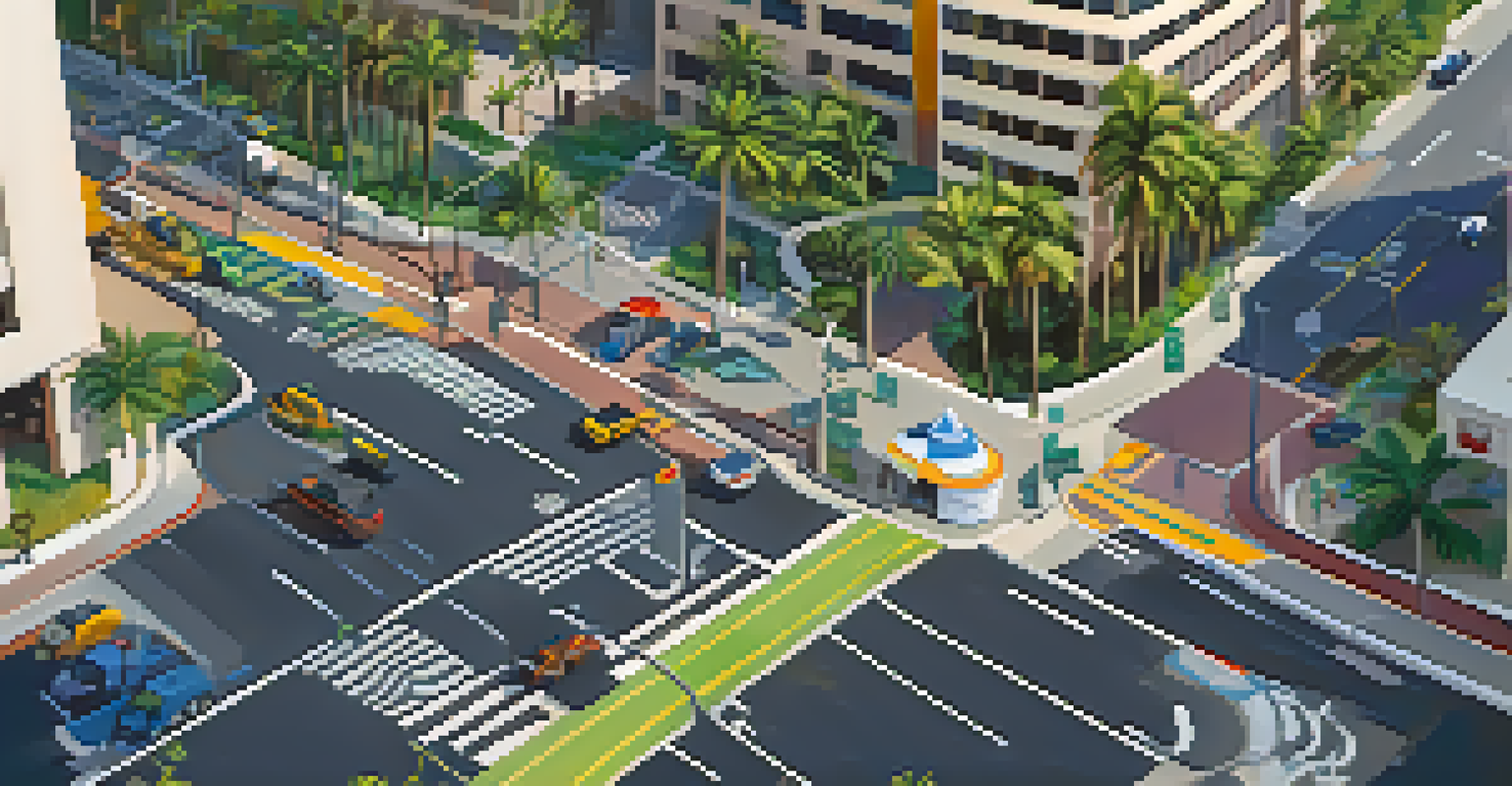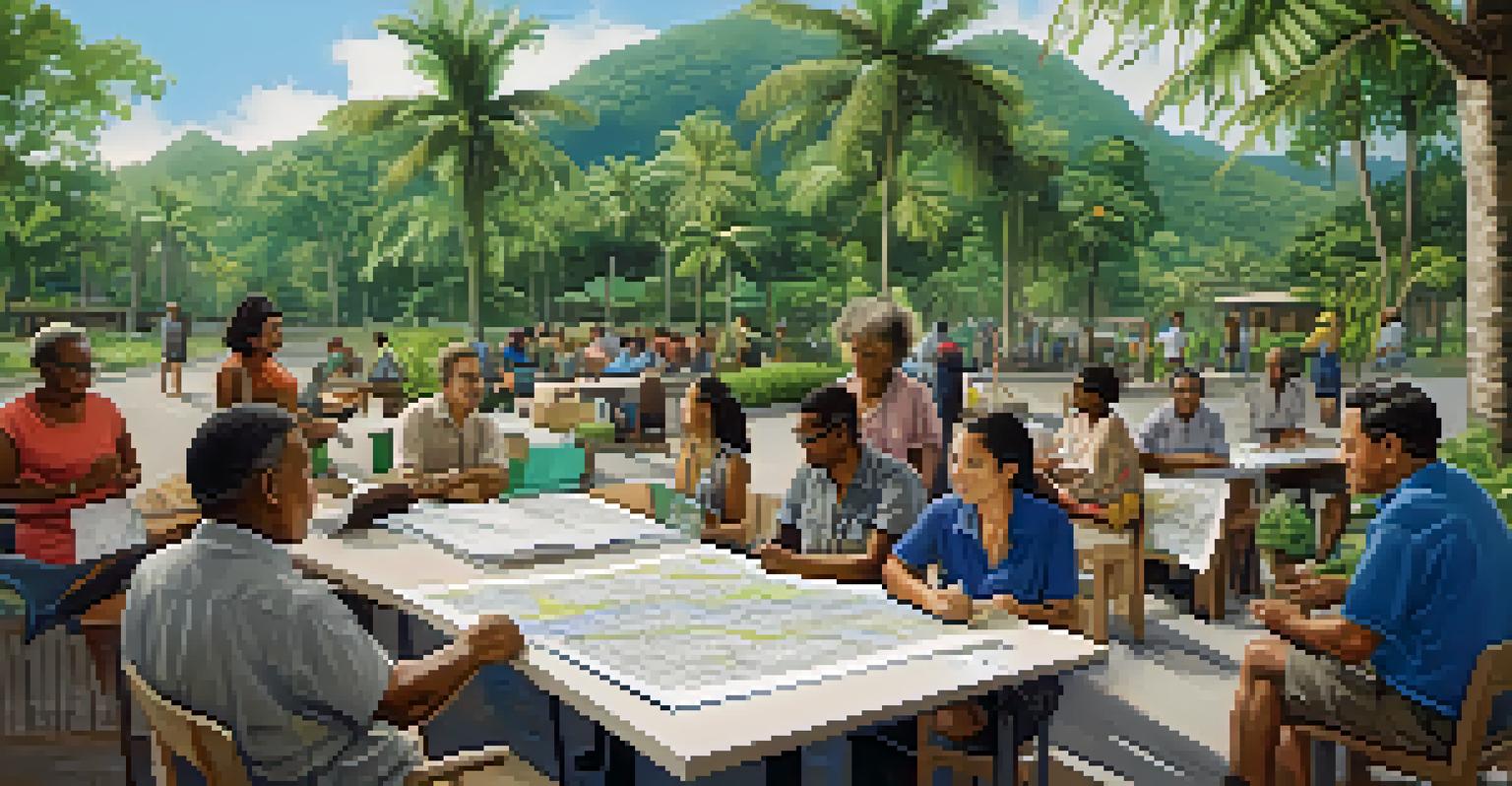Hawaii's Roadways: Challenges and Innovations in Development

Understanding Hawaii's Unique Geographic Challenges
Hawaii's roadways face unique challenges due to its geographical features. The islands' volcanic landscapes create rugged terrains that complicate road construction and maintenance. Additionally, the frequent earthquakes and heavy rainfall can lead to landslides, further obstructing travel and transport.
The road ahead is not just a path to travel, but a reflection of our commitment to the environment and community.
These natural elements not only pose risks to infrastructure but also increase the costs associated with road development. As a result, planners must consider alternative routes or innovative engineering solutions to ensure the safety and accessibility of these vital paths. The need for resilience in roadway design is crucial for the islands' sustainability.
Moreover, the limited space on the islands means that expanding existing roadways is often not an option. This necessitates a focus on innovative solutions that maximize the efficiency of the current infrastructure while minimizing environmental impact.
The Impact of Tourism on Roadway Development
Tourism is a major economic driver in Hawaii, significantly influencing roadway development. With millions of visitors each year, the existing infrastructure often struggles to accommodate the influx of traffic, leading to congestion and wear on roadways. This creates a pressing need for continual improvements and expansions.

To handle this, developers are exploring innovative solutions such as smart traffic management systems. These systems can dynamically adjust traffic signals and provide real-time updates to drivers, helping to minimize bottlenecks. Such technology not only enhances the visitor experience but also decreases environmental strain.
Hawaii's Geography Challenges Roadways
The islands' volcanic landscapes and natural events like earthquakes and heavy rainfall complicate road construction and maintenance.
Furthermore, integrating multi-modal transportation options, like bike lanes and shuttle services, can help alleviate pressure on the roads. By encouraging visitors to explore alternative modes of travel, Hawaii can preserve its natural beauty while ensuring that tourists and locals alike can navigate the islands smoothly.
Innovative Technologies Shaping Roadway Infrastructure
Technological advancements are playing a pivotal role in the evolution of Hawaii's roadways. From using drones for surveying to employing advanced materials that withstand harsh weather conditions, these innovations promise to enhance road quality and longevity. For instance, the use of permeable pavement can manage stormwater more effectively, reducing flooding risks.
Infrastructure is not just about building roads; it's about creating connections that sustain our communities and our ecosystems.
Moreover, the integration of renewable energy solutions, such as solar panels along roadways, is gaining traction. These not only provide energy for streetlights but also contribute to Hawaii's ambitious sustainability goals. By marrying technology with environmental consciousness, road developers can create a more resilient infrastructure.
Additionally, the adoption of electric vehicle (EV) charging stations along major routes supports the shift towards greener transportation. As more residents and tourists opt for electric cars, having accessible charging points will be crucial in promoting eco-friendly travel across the islands.
Community Involvement in Roadway Planning
Community engagement is essential in the planning and development of Hawaii's roadways. Local residents bring valuable insights about their needs and concerns, ensuring that projects align with the community's vision. This collaborative approach fosters a sense of ownership and responsibility towards the infrastructure.
Public forums, surveys, and workshops are often used to gather feedback, allowing residents to voice their opinions on proposed plans. By prioritizing community input, developers can create roadways that not only serve tourists but also enhance the daily lives of local residents. This inclusive strategy helps build trust between the government and the community.
Tourism Drives Infrastructure Needs
With millions of visitors annually, Hawaii's roadways face congestion and wear, necessitating improvements and innovative traffic solutions.
Furthermore, involving community members in the maintenance and beautification of roadways can lead to a stronger connection to the environment. Initiatives like adopt-a-highway programs encourage locals to take pride in their surroundings, promoting both civic engagement and environmental stewardship.
Environmental Considerations in Roadway Projects
Hawaii's unique ecosystems demand careful consideration during roadway development. Projects must balance the need for infrastructure with the preservation of the islands' natural beauty and biodiversity. This often involves extensive environmental assessments to evaluate potential impacts on local wildlife and habitats.
Innovative designs, such as wildlife corridors and native landscaping, can help mitigate adverse effects. By integrating these elements, developers can ensure that roadways coexist harmoniously with Hawaii's rich ecosystems. This approach not only benefits the environment but also enhances the aesthetic appeal of the roads.
Additionally, sustainable practices like using recycled materials in construction further reduce environmental footprints. As Hawaii continues to evolve, prioritizing eco-friendly solutions in roadway projects will be crucial for maintaining the islands' allure and ecological health.
Funding and Financial Challenges in Roadway Development
Funding remains a significant hurdle in developing and maintaining Hawaii's roadways. Limited state and federal budgets often lead to tough decisions about which projects receive priority. This financial pressure can result in delays or scaled-back initiatives, impacting overall infrastructure quality.
To address this, innovative financing strategies, such as public-private partnerships (PPPs), are being explored. By collaborating with private entities, the state can leverage additional resources and expertise, leading to more efficient project completion. These partnerships can also introduce new technologies and practices that may not be available through traditional funding.
Community Engagement Enhances Projects
Involving locals in roadway planning and maintenance fosters a sense of ownership and ensures that developments meet community needs.
Furthermore, exploring alternative sources of revenue, such as tolls or dedicated transportation taxes, could provide a more stable funding stream. By diversifying funding mechanisms, Hawaii can ensure that its roadways are not only safe and efficient but also equipped to meet future demands.
Future Trends in Hawaii's Roadway Development
Looking ahead, several trends are shaping the future of roadway development in Hawaii. As the islands continue to embrace smart city initiatives, the integration of technology into infrastructure will become increasingly common. This includes everything from automated traffic signals to apps that provide real-time information on road conditions.
Sustainability will also remain at the forefront of development decisions. With rising awareness of climate change, projects will increasingly prioritize eco-friendly materials and practices. This shift not only benefits the environment but also aligns with Hawaii's commitment to preserving its natural resources for future generations.

Lastly, a focus on resilience will be paramount. As climate change impacts become more pronounced, roadways must be designed to withstand extreme weather events. By adopting innovative engineering solutions and prioritizing adaptability, Hawaii can create a transportation network that will thrive in the face of future challenges.